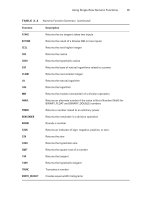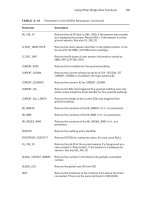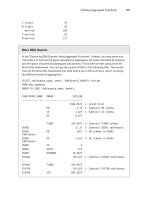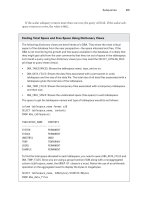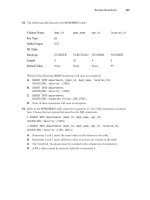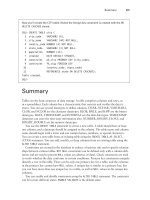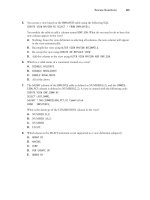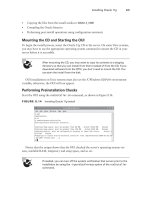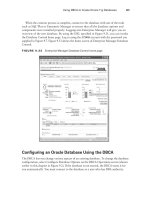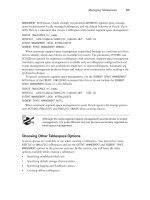Tài liệu OCA: Oracle Database 11g Administrator Certified Associate Study Guide- P4 doc
Bạn đang xem bản rút gọn của tài liệu. Xem và tải ngay bản đầy đủ của tài liệu tại đây (527.56 KB, 50 trang )
Using Single-Row Numeric Functions
81
Function Description
ATAN2
Returns the arc tangent; takes two inputs
BITAND
Returns the result of a bitwise
AND
on two inputs
CEIL
Returns the next higher integer
COS
Returns the cosine
COSH
Returns the hyperbolic cosine
EXP
Returns the base of natural logarithms raised to a power
FLOOR
Returns the next smaller integer
LN
Returns the natural logarithm
LOG
Returns the logarithm
MOD
Returns the modulo (remainder) of a division operation
NANVL
Returns an alternate number if the value is Not a Number (NaN) for
BINARY_FLOAT and BINARY_DOUBLE numbers
POWER
Returns a number raised to an arbitrary power
REMAINDER
Returns the remainder in a division operation
ROUND
Rounds a number
SIGN
Returns an indicator of sign: negative, positive, or zero
SIN
Returns the sine
SINH
Returns the hyperbolic sine
SQRT
Returns the square root of a number
TAN
Returns the tangent
TANH
Returns the hyperbolic tangent
TRUNC
Truncates a number
WIDTH_BUCKET
Creates equal-width histograms
TABLE 2.2 Numeric Function Summary (continued)
95127c02.indd 81 2/18/09 6:46:40 AM
Please purchase PDF Split-Merge on www.verypdf.com to remove this watermark.
82
Chapter 2
N
Using Single-Row Functions
Numeric Function Descriptions
Numeric functions have numeric arguments and return numeric values. The trigonometric
functions all operate on radians, not degrees.
The numeric functions are arranged in alphabetical order, with descriptions and exam-
ples of each one.
SIGN
,
ROUND
, and
TRUNC
are most commonly used numeric functions—pay particular
attention to them.
FLOOR
,
CEIL
,
MOD
, and
REMAINDER
are also important functions that can
appear in the test.
TRUNC
and
ROUND
functions can take numeric input or a datetime input.
These two functions are discussed in the “Using Single-Row Date Functions” section to
illustrate their behavior with a datetime datatype input.
ABS
ABS(n)
takes a single argument, where
n
is a numeric datatype (NUMBER, BINARY_
FLOAT or BINARY_DOUBLE). This function returns the absolute value of
n
.
SELECT ABS(-52) negative, ABS(52) positive
FROM dual;
NEGATIVE POSITIVE
---------- ----------
52 52
ACOS
ACOS(n)
takes a single argument, where
n
is a numeric datatype between –1 and 1. This
function returns the arc cosine of
n
expressed in radians, accurate to 30 digits of precision.
SELECT ACOS(-1) PI, ACOS(0) ACOSZERO,
ACOS(.045) ACOS045, ACOS(1) ZERO
FROM dual;
PI ACOSZERO ACOS045 ZERO
---------- ---------- ---------- ----------
3.14159265 1.57079633 1.52578113 0
ASIN
ASIN(n)
takes a single argument, where
n
is a numeric datatype between –1 and 1. This
function returns the arc sine of
n
expressed in radians, accurate to 30 digits of precision.
SELECT ASIN(1) high, ASIN(0) middle, ASIN(-1) low
FROM dual;
95127c02.indd 82 2/18/09 6:46:40 AM
Please purchase PDF Split-Merge on www.verypdf.com to remove this watermark.
Using Single-Row Numeric Functions
83
HIGH MIDDLE LOW
---------- ---------- ----------
1.57079633 0 -1.5707963
ATAN
ATAN(n)
takes a single argument, where
n
is a numeric datatype. This function returns the
arc tangent of
n
expressed in radians, accurate to 30 digits of precision.
SELECT ATAN(9E99) high, ATAN(0) middle, ATAN(-9E99) low
FROM dual;
HIGH MIDDLE LOW
---------- ---------- ----------
1.57079633 0 -1.5707963
ATAN2
ATAN2(n1, n2)
takes two arguments, where
n1
and
n2
are numbers. This function returns
the arc tangent of
n1
and
n2
expressed in radians, accurate to 30 digits of precision.
ATAN2(n1,n2)
is equivalent to
ATAN(n1/n2)
.
SELECT ATAN2(9E99,1) high, ATAN2(0,3.1415) middle, ATAN2(-9E99,1) low
FROM dual;
HIGH MIDDLE LOW
---------- ---------- ----------
1.57079633 0 -1.5707963
BITAND
BITAND(n1, n2)
takes two arguments, where
n1
and
n2
are positive integers or zero. This
function performs a bitwise
AND
operation on the two input values and returns the results,
also an integer. It is used to examine bit fields.
Here are two examples of
BITAND
. The first one performs a bitwise
AND
operation on 6
(binary 0110) and 3 (binary 0011). The result is 2 (binary 0010). Similarly, the bitwise
AND
between 8 (binary 1000) and 2 (binary 0010) is 0 (0000).
SELECT BITAND(6,3) T1, BITAND(8,2) T2
FROM dual;
T1 T2
---------- ----------
2 0
95127c02.indd 83 2/18/09 6:46:40 AM
Please purchase PDF Split-Merge on www.verypdf.com to remove this watermark.
84
Chapter 2
N
Using Single-Row Functions
CEIL
CEIL(n)
takes a single argument, where
n
is a numeric datatype. This function returns the
smallest integer that is greater than or equal to
n
.
CEIL
rounds up to a whole number. See
also
FLOOR
.
SELECT CEIL(9.8), CEIL(-32.85), CEIL(0), CEIL(5)
FROM dual;
CEIL(9.8) CEIL(-32.85) CEIL(0) CEIL(5)
---------- ------------ ---------- ----------
10 -32 0 5
COS
COS(n)
takes a single argument, where
n
is a numeric datatype in radians. This function
returns the cosine of
n
, accurate to 36 digits of precision.
SELECT COS(-3.14159) FROM dual;
COS(-3.14159)
-------------
-1
COSH
COSH(n)
takes a single argument, where
n
is a numeric datatype. This function returns the
hyperbolic cosine of
n
, accurate to 36 digits of precision.
SELECT COSH(1.4) FROM dual;
COSH(1.4)
----------
2.15089847
EXP
EXP(n)
takes a single argument, where
n
is a numeric datatype. This function returns
e
(the
base of natural logarithms) raised to the
n
power, accurate to 36 digits of precision.
SELECT EXP(1) “e” FROM dual;
e
----------
2.71828183
95127c02.indd 84 2/18/09 6:46:40 AM
Please purchase PDF Split-Merge on www.verypdf.com to remove this watermark.
Using Single-Row Numeric Functions
85
FLOOR
FLOOR(n)
takes a single argument, where
n
is a numeric datatype. This function returns the
largest integer that is less than or equal to
n
.
FLOOR
rounds down to a whole number. See
also
CEIL
.
SELECT FLOOR(9.8), FLOOR(-32.85), FLOOR(137)
FROM dual;
FLOOR(9.8) FLOOR(-32.85) FLOOR(137)
---------- ------------- ----------
9 -33 137
LN
LN(n)
takes a single argument, where
n
is a numeric datatype greater than 0. This function
returns the natural logarithm of
n
, accurate to 36 digits of precision.
SELECT LN(2.7) FROM dual;
LN(2.7)
----------
.993251773
LOG
LOG(n1, n2)
takes two arguments, where
n1
and
n2
are numeric datatypes. This function
returns the logarithm base
n1
of
n2
, accurate to 36 digits of precision.
SELECT LOG(8,64), LOG(3,27), LOG(2,1024), LOG(2,8)
FROM dual;
LOG(8,64) LOG(3,27) LOG(2,1024) LOG(2,8)
---------- ---------- ----------- ----------
2 3 10 3
MOD
MOD(n1, n2)
takes two arguments, where
n1
and
n2
are any numeric datatype. This func-
tion returns
n1
modulo
n2
, or the remainder of
n1
divided by
n2
. If
n1
is negative, the result
is negative. The sign of
n2
has no effect on the result. If
n2
is zero, the result is
n1
. See also
REMAINDER
.
SELECT MOD(14,5), MOD(8,2.5), MOD(-64,7), MOD(12,0)
FROM dual;
95127c02.indd 85 2/18/09 6:46:41 AM
Please purchase PDF Split-Merge on www.verypdf.com to remove this watermark.
86
Chapter 2
N
Using Single-Row Functions
MOD(14,5) MOD(8,2.5) MOD(-64,7) MOD(12,0)
---------- ---------- ---------- ---------
4 .5 -1 12
NANVL
This function is used with BINARY_FLOAT and BINARY_DOUBLE datatype numbers to
return an alternate value if the input is NaN.
The following example defines the
NULL
display as
?
to show
NULL
value. The
TO_BINARY_
FLOAT
function (discussed later in the chapter) is used to convert input to a BINARY_
FLOAT datatype number.
SET NULL ?
SELECT NANVL(TO_BINARY_FLOAT(‘NaN’), 0) T1,
NANVL(TO_BINARY_FLOAT(‘NaN’), NULL) T2
FROM dual;
T1 T2
---------- ----------
0 ?
POWER
POWER(n1, n2)
takes two arguments, where
n1
and
n2
are numeric datatypes. This function
returns
n1
to the
n2
power.
SELECT POWER(2,10), POWER(3,3), POWER(5,3), POWER(2,-3)
FROM dual;
POWER(2,10) POWER(3,3) POWER(5,3) POWER(2,-3)
----------- ---------- ---------- -----------
1024 27 125 .125
REMAINDER
REMAINDER(n1, n2)
takes two arguments, where
n1
and
n2
are any numeric datatype. This
function returns the remainder of
n1
divided by
n2
. If
n1
is negative, the result is negative.
The sign of
n2
has no effect on the result. If
n2
is zero and the datatype of
n1
is NUMBER,
an error is returned; if the datatype of
n1
is BINARY_FLOAT or BINARY_DOUBLE,
NaNis returned. See also MOD.
SELECT REMAINDER(13,5), REMAINDER(12,5), REMAINDER(12.5, 5)
FROM dual;
95127c02.indd 86 2/18/09 6:46:41 AM
Please purchase PDF Split-Merge on www.verypdf.com to remove this watermark.
Using Single-Row Numeric Functions
87
REMAINDER(13,5) REMAINDER(12,5) REMAINDER(12.5,5)
--------------- --------------- -----------------
-2 2 2.5
The difference between
MOD
and
REMAINDER
is that
MOD
uses the
FLOOR
function, whereas
REMAINDER
uses the
ROUND
function in the formula. If you apply
MOD
function to the previous
example, the results are the same except for the first column:
SELECT MOD(13,5), MOD(12,5), MOD(12.5, 5)
FROM dual;
MOD(13,5) MOD(12,5) MOD(12.5,5)
---------- ---------- -----------
3 2 2.5
Here is another example of using
REMAINDER
with a BINARY_FLOAT number, having
n2
as zero:
SELECT REMAINDER(TO_BINARY_FLOAT(‘13.0’), 0) RBF
from dual;
RBF
----------
Nan
ROUND
ROUND(n1 [,n2])
takes two arguments, where
n1
is a numeric datatype and
n2
is an integer.
This function returns
n1
rounded to
n2
digits of precision to the right of the decimal. If
n2
is negative,
n1
is rounded to the left of the decimal. If
n2
is omitted, the default is zero. This
function is similar to
TRUNC
.
SELECT ROUND(123.489), ROUND(123.489, 2),
ROUND(123.489, -2), ROUND(1275, -2)
FROM dual;
ROUND(123.489) ROUND(123.489,2) ROUND(123.489,-2) ROUND(1275,-2)
-------------- ---------------- ----------------- --------------
123 123.49 100 1300
95127c02.indd 87 2/18/09 6:46:41 AM
Please purchase PDF Split-Merge on www.verypdf.com to remove this watermark.
88
Chapter 2
N
Using Single-Row Functions
SIGN
SIGN(n)
takes a single argument, where
n
is a numeric datatype. This function returns –1 if
n
is negative, 1 if
n
is positive, and 0 if
n
is 0.
SELECT SIGN(-2.3), SIGN(0), SIGN(47)
FROM dual;
SIGN(-2.3) SIGN(0) SIGN(47)
---------- ---------- ----------
-1 0 1
SIN
SIN(n)
takes a single argument, where
n
is a number in radians. This function returns the
sine of
n
, accurate to 36 digits of precision.
SELECT SIN(1.57079) FROM dual;
SIN(1.57079)
------------
1
SINH
SINH(n)
takes a single argument, where
n
is a number. This function returns the hyperbolic
sine of
n
, accurate to 36 digits of precision.
SELECT SINH(1) FROM dual;
SINH(1)
----------
1.17520119
SQRT
SQRT(n)
takes a single argument, where
n
is a numeric datatype. This function returns the
square root of
n.
SELECT SQRT(64), SQRT(49), SQRT(5)
FROM dual;
SQRT(64) SQRT(49) SQRT(5)
---------- ---------- ----------
8 7 2.23606798
95127c02.indd 88 2/18/09 6:46:41 AM
Please purchase PDF Split-Merge on www.verypdf.com to remove this watermark.
Using Single-Row Numeric Functions
89
TAN
TAN(n)
takes a single argument, where
n
is a numeric datatype in radians. This function
returns the tangent of
n
, accurate to 36 digits of precision.
SELECT TAN(1.57079633/2) “45_degrees”
FROM dual;
45_Degrees
----------
1
TANH
TANH(n)
takes a single argument, where
n
is a numeric datatype. This function returns the
hyperbolic tangent of
n
, accurate to 36 digits of precision.
SELECT TANH( ACOS(-1) ) hyp_tan_of_pi
FROM dual;
HYP_TAN_OF_PI
-------------
.996272076
TRUNC
TRUNC(n1 [,n2])
takes two arguments, where
n1
is a numeric datatype and
n2
is an integer.
This function returns
n1
truncated to
n2
digits of precision to the right of the decimal. If
n2
is negative,
n1
is truncated to the left of the decimal. See also
ROUND
.
SELECT TRUNC(123.489), TRUNC(123.489, 2),
TRUNC(123.489, -2), TRUNC(1275, -2)
FROM dual;
TRUNC(123.489) TRUNC(123.489,2) TRUNC(123.489,-2) TRUNC(1275,-2)
-------------- ---------------- ----------------- --------------
123 123.48 100 1200
WIDTH_BUCKET
You can use
WIDTH_BUCKET(n1, min_val, max_val, buckets)
to build histograms of equal
width. The first argument
n1
can be an expression of a numeric or datetime datatype. The
second and third arguments,
min_val
and
max_val
, indicate the end points for the histo-
gram’s range. The fourth argument,
buckets
, indicates the number of buckets.
95127c02.indd 89 2/18/09 6:46:41 AM
Please purchase PDF Split-Merge on www.verypdf.com to remove this watermark.
90
Chapter 2
N
Using Single-Row Functions
The following example divides the salary into a 10-bucket histogram within the range
2,500 to 11,000. If the salary falls below 2500, it will be in the underflow bucket (bucket 0),
and if the salary exceeds 11,000, it will be in the overflow bucket (
buckets
+ 1).
SELECT first_name, salary,
WIDTH_BUCKET(salary, 2500, 11000, 10) hist
FROM employees
WHERE first_name like ‘J%’;
FIRST_NAME SALARY HIST
-------------------- ---------- ----------
Jennifer 4400 3
John 8200 7
Jose Manuel 7800 7
Julia 3200 1
James 2400 0
James 2500 1
Jason 3300 1
John 2700 1
Joshua 2500 1
John 14000 11
Janette 10000 9
Jonathon 8600 8
Jack 8400 7
Jean 3100 1
Julia 3400 2
Jennifer 3600 2
Using Single-Row Date Functions
Single-row date functions operate on datetime datatypes. A datetime is a coined word to
identify datatypes used to define dates and times. The datetime datatypes in Oracle 11g are
DATE, TIMESTAMP, and INTERVAL. Most have one or more date arguments, and most
return a datetime value. Date data is stored internally as numbers. The whole-number por-
tion is the number of days since January 1, 4712 BC, and the decimal portion is the frac-
tion of a day (for example, 0.5=12 hours).
95127c02.indd 90 2/18/09 6:46:41 AM
Please purchase PDF Split-Merge on www.verypdf.com to remove this watermark.
Using Single-Row Date Functions
91
Date-Format Conversion
National-language support (NLS) parameters and arguments allow you to internationalize
your Oracle database system. NLS internationalizations include date representations, char-
acter sets, alphabets, and alphabetical ordering.
Oracle will implicitly or automatically convert its numeric date data to and from char-
acter data using the format model specified with
NLS_DATE_FORMAT
. The default format is
DD-MON-RR
(see Table 2.7). You can change this date-format model for each session with the
ALTER SESSION SET NLS_DATE_FORMAT
command. Here’s an example:
SQL> SELECT SYSDATE FROM dual;
SYSDATE
---------
31-MAR-08
SQL> ALTER SESSION SET NLS_DATE_FORMAT=’DD-Mon-YYYY HH24:MI:SS’;
Session altered.
SQL> SELECT SYSDATE FROM dual;
SYSDATE
--------------------
31-Mar-2008 10:19:11
This
ALTER SESSION
command will set the implicit conversion mechanism to display
date data in the format specified, such as 12-Dec-2002 15:45:32. This conversion works
both ways. If the character string
‘30-Nov-2002 20:30:00’
were inserted, updated, or
assigned to a date column or variable, the correct date would be entered.
If the format model were
DD/MM/YY
or
MM/DD/YY
, there could be some ambiguity in
the conversion of some dates, such as 12 April 2000 (04/12/00 or 12/04/00). To avoid
problems with implicit conversions, Oracle provides explicit date/character-conversion
functions:
TO_DATE
,
TO_CHAR
,
TO_TIMESTAMP
,
TO_TIMESTAMP_TZ
,
TO_DSINTERVAL
, and
TO_YMINTERVAL
. These explicit conversion functions are covered in the “Using Single-Row
Conversion Functions” section later in this chapter.
Date-Function Overview
Table 2.3 summarizes the single-row date functions. I will cover each of these functions in
the “Date-Function Descriptions” section.
95127c02.indd 91 2/18/09 6:46:41 AM
Please purchase PDF Split-Merge on www.verypdf.com to remove this watermark.
92
Chapter 2
N
Using Single-Row Functions
TABLE 2.3 Date-Function Summary
Function Description
ADD_MONTHS
Adds a number of months to a date
CURRENT_DATE
Returns the current date and time in a DATE datatype
CURRENT_TIMESTAMP
Returns the current date and time in a TIMESTAMP datatype
DBTIMEZONE
Returns the database’s time zone
EXTRACT
Returns a component of a date/time expression
FROM_TZ
Returns a timestamp with time zone for a given timestamp
LAST_DAY
Returns the last day of a month
LOCALTIMESTAMP
Returns the current date and time in the session time zone
MONTHS_BETWEEN
Returns the number of months between two dates
NEW_TIME
Returns the date/time in a different time zone
NEXT_DAY
Returns the next day of a week following a given date
ROUND
Rounds a date/time
SESSIONTIMEZONE
Returns the time zone for the current session
SYS_EXTRACT_UTC
Returns the UTC (GMT) for a timestamp with a time zone
SYSDATE
Returns the current date and time in the DATE datatype
SYSTIMESTAMP
Returns the current timestamp in the TIMESTAMP datatype
TRUNC
Truncates a date to a given granularity
TZ_OFFSET
Returns the offset from UTC for a time zone name
Date-Function Descriptions
The date functions are arranged in alphabetical order except the first three, with descrip-
tions and examples of each one.
SYSDATE
,
SYSTIMESTAMP
, and
LOCALTIMESTAMP
are used in
many examples, and hence I’ll discuss them first.
95127c02.indd 92 2/18/09 6:46:41 AM
Please purchase PDF Split-Merge on www.verypdf.com to remove this watermark.
Using Single-Row Date Functions
93
SYSDATE
SYSDATE
takes no arguments and returns the current date and time to the second for the
operating-system host where the database resides. The value is returned in a DATE data-
type. The format that the value returned is based on
NLS_DATE_FORMAT
, which can be
altered for the session using the
ALTER SESSION SET NLS_DATE_FORMAT
command. The for-
mat mask for dates and timestamps are discussed later in the chapter.
ALTER SESSION SET NLS_DATE_FORMAT=’DD-MON-YYYY HH:MI:SS AM’;
Session altered.
SELECT SYSDATE FROM dual;
SYSDATE
-----------------------
31-MAR-2008 12:00:13 PM
SYSDATE
is one of the most commonly used Oracle functions. There’s a
good chance you’ll see it on the exam. Since the
SYSDATE
value is returned
based on the time of the host server where the database resides, the result
will be the same for a user sitting in New York or one in Hong Kong.
SYSTIMESTAMP
SYSTIMESTAMP
takes no arguments and returns a TIMESTAMP WITH TIME ZONE for
the current database date and time (the time of the host server where the database resides).
The fractional second is returned with six digits of precision. The format of the value
returned is based on
NLS_TIMESTAMP_TZ_FORMAT
, which can be altered for the session using
the
ALTER SESSION SET NLS_TIMESTAMP_TZ_FORMAT
command.
SQL> SELECT SYSDATE, SYSTIMESTAMP FROM dual;
SYSDATE
SYSTIMESTAMP
-------------------------------------
31-MAR-08
31-MAR-08 12.01.49.280000 PM -05:00
ALTER SESSION SET NLS_DATE_FORMAT=’DD-MON-YYYY HH24:MI:SS’;
Session altered.
95127c02.indd 93 2/18/09 6:46:41 AM
Please purchase PDF Split-Merge on www.verypdf.com to remove this watermark.
94
Chapter 2
N
Using Single-Row Functions
ALTER SESSION SET
NLS_TIMESTAMP_TZ_FORMAT=’YYYY-MON-DD HH:MI:SS.FF TZR’;
Session altered.
SELECT SYSDATE, SYSTIMESTAMP FROM dual;
SYSDATE
SYSTIMESTAMP
-------------------------------------
31-MAR-2008 12:09:51
2008-MAR-31 12:09:51.429000 -05:00
LOCALTIMESTAMP
LOCALTIMESTAMP([p])
returns the current date and time in the session’s time zone to
p
digits
of precision.
p
can be 0 to 9 and defaults to 6. This function returns the value in the datatype
TIMESTAMP. You can set the client time zone using the
ALTER SESSION SET TIME_ZONE
command.
The following example illustrates
LOCALTIMESTAMP
and how to change the time zone for
the session. The database is in U.S./Central time zone, and the client is in U.S./Eastern time
zone. See also
CURRENT_TIMESTAMP
.
SELECT SYSTIMESTAMP, LOCALTIMESTAMP FROM dual;
SYSTIMESTAMP
LOCALTIMESTAMP
-----------------------------------------------------
31-MAR-08 01.02.49.272000 PM -05:00
31-MAR-08 02.02.49.272000 PM
ALTER SESSION SET TIME_ZONE = ‘-8:00’;
ADD_MONTHS
ADD_MONTHS(d, i)
takes two arguments, where
d
is a date and
i
is an integer. This function
returns the date
d
plus
i
months. If
i
is a decimal number, the database will implicitly con-
vert it to an integer by truncating the decimal portion (for example, 3.9 becomes 3). If
<d>
is the last day of the month or the resulting month has fewer days, then the result is the last
day of the resulting month.
SELECT SYSDATE, ADD_MONTHS(SYSDATE, -1) PREV_MONTH,
ADD_MONTHS(SYSDATE, 12) NEXT_YEAR
FROM dual;
95127c02.indd 94 2/18/09 6:46:41 AM
Please purchase PDF Split-Merge on www.verypdf.com to remove this watermark.
Using Single-Row Date Functions
95
SYSDATE PREV_MONT NEXT_YEAR
--------- --------- ---------
31-MAR-08 29-FEB-08 31-MAR-09
CURRENT_DATE
CURRENT_DATE
takes no arguments and returns the current date in the Gregorian calendar
for the session’s (client) time zone. This function is similar to
SYSDATE
, whereas
SYSDATE
returns the current date for the database’s (host’s) time zone. You can set the client time
zone using the
ALTER SESSION SET TIME_ZONE
command.
The following example illustrates
CURRENT_DATE
and how to change the time zone for
the session. The database is in U.S./Central time zone, and the client is in U.S./Mountain
time zone.
ALTER SESSION SET NLS_DATE_FORMAT=’DD-Mon-YYYY HH24:MI:SS’;
Session altered.
SELECT SYSDATE, CURRENT_DATE FROM dual;
SYSDATE CURRENT_DATE
-------------------- --------------------
31-Mar-2008 10:52:34 31-Mar-2008 09:52:35
ALTER SESSION SET TIME_ZONE = ‘US/Eastern’;
Session altered.
SELECT SYSDATE, CURRENT_DATE FROM dual;
SYSDATE CURRENT_DATE
-------------------- --------------------
31-Mar-2008 10:53:46 31-Mar-2008 11:53:47
CURRENT_TIMESTAMP
CURRENT_TIMESTAMP([p])
returns the current date and time in the session’s time zone to
p
dig-
its of precision.
p
can be an integer 0 through 9 and defaults to 6. See also
LOCALTIMESTAMP
.
This function is similar to
CURRENT_DATE
.
CURRENT_DATE
returns result in the DATE data-
type, whereas
CURRENT_TIMESTAMP
returns the result in the TIMESTAMP WITH TIME
ZONE datatype.
95127c02.indd 95 2/18/09 6:46:41 AM
Please purchase PDF Split-Merge on www.verypdf.com to remove this watermark.
96
Chapter 2
N
Using Single-Row Functions
SQL> SELECT CURRENT_DATE, CURRENT_TIMESTAMP FROM dual;
CURRENT_DATE
CURRENT_TIMESTAMP
---------------------------------------
31-Mar-2008 12:23:43
31-MAR-08 12.23.43.305000 PM US/EASTERN
DBTIMEZONE
DBTIMEZONE
returns the database’s time zone, as set by the latest
CREATE DATABASE
or
ALTER
DATABASE SET TIME_ZONE
statement. Note that after changing the database time zone with
the
ALTER DATABASE
statement, the database must be bounced (restarted) for the change to
take effect. The time zone is a character string specifying the hours and minutes offset from
UTC (Coordinated Universal Time, also known as GMT, or Greenwich mean time) or a
time zone region name. The valid time zone region names can be found in the
TZNAME
col-
umn of the view
V$TIMEZONE_NAMES
. The default time zone for the database is UTC (00:00)
if you do not explicitly set the time zone during database creation.
SQL> SELECT DBTIMEZONE FROM dual;
DBTIME
------
+00:00
EXTRACT
EXTRACT(c FROM dt)
extracts and returns the specified component
c
of date/time or interval
expression
dt
. The valid components are
YEAR
,
MONTH
,
DAY
,
HOUR
,
MINUTE
,
SECOND
,
TIMEZONE_
HOUR
,
TIMEZONE_MINUTE
,
TIMEZONE_REGION
, and
TIMEZONE_ABBR
. The specified component
must exist in the expression. So, to extract a
TIMEZONE_HOUR
, the date/time expression must
be a TIMESTAMP WITH TIME ZONE datatype.
Though
HOUR
,
MINUTE
, and
SECOND
exist in the
DATE
datatype, you can extract only
YEAR
,
MONTH
, and
DAY
from the
DATE
dataype expressions.
SELECT SYSDATE, EXTRACT(YEAR FROM SYSDATE) year_d
FROM dual;
SYSDATE YEAR_D
-------------------- ----------
31-MAR-2008 12:29:02 2008
You can extract
YEAR
,
MONTH
,
DAY
,
HOUR
,
MINUTE
, and
SECOND
from the TIMESTAMP
datatype expression. You can extract all the components from the TIMESTAMP WITH
TIMEZONE datatype expression.
95127c02.indd 96 2/18/09 6:46:42 AM
Please purchase PDF Split-Merge on www.verypdf.com to remove this watermark.
Using Single-Row Date Functions
97
SELECT LOCALTIMESTAMP,
EXTRACT(YEAR FROM LOCALTIMESTAMP) YEAR_TS,
EXTRACT(DAY FROM LOCALTIMESTAMP) DAY_TS,
EXTRACT(SECOND FROM LOCALTIMESTAMP) SECOND_TS
FROM dual;
LOCALTIMESTAMP YEAR_TS DAY_TS SECOND_TS
----------------------------- ------- ------- ---------
31-MAR-08 02.09.32.972000 PM 2008 31 32.972
FROM_TZ
FROM_TZ(ts, tz)
returns a TIMESTAMP WITH TIME ZONE for the timestamp
ts
using
time zone value
tz
. The character string
tz
specifies the hours and minutes offset from UTC
or is a time zone region name. The valid time zone region names can be found in the
TZNAME
column of the view
V$TIMEZONE_NAMES
.
SELECT LOCALTIMESTAMP, FROM_TZ(LOCALTIMESTAMP, ‘Japan’) Japan,
FROM_TZ(LOCALTIMESTAMP, ‘-5:00’) Central
FROM dual;
LOCALTIMESTAMP
JAPAN
CENTRAL
--------------------------------------
31-MAR-08 03.17.38.447000 PM
31-MAR-08 03.17.38.447000 PM JAPAN
31-MAR-08 03.17.38.447000 PM -05:00
LAST_ DAY
LAST_DAY(d)
takes a single argument, where
d
is a date. This function returns the last day
of the month for the date
d
. The return datatype is DATE.
SELECT SYSDATE,
LAST_DAY(SYSDATE) END_OF_MONTH,
LAST_DAY(SYSDATE)+1 NEXT_MONTH
FROM dual;
SYSDATE END_OF_MONTH NEXT_MONTH
----------- ------------ -----------
09-SEP-2007 30-SEP-2007 01-OCT-2007
95127c02.indd 97 2/18/09 6:46:42 AM
Please purchase PDF Split-Merge on www.verypdf.com to remove this watermark.
98
Chapter 2
N
Using Single-Row Functions
MONTHS_BETWEEN
MONTHS_BETWEEN(d1, d2)
takes two arguments, where
d1
and
d2
are both dates. This func-
tion returns the number of months that
d2
is later than
d1
. A whole number is returned if
d1
and
d2
are the same day of the month or if both dates are the last day of a month.
SELECT MONTHS_BETWEEN(‘31-MAR-08’, ‘30-SEP-08’) E1,
MONTHS_BETWEEN(‘11-MAR-08’, ‘30-SEP-08’) E2,
MONTHS_BETWEEN(‘01-MAR-08’, ‘30-SEP-08’) E3,
MONTHS_BETWEEN(‘31-MAR-08’, ‘30-SEP-07’) E4
FROM dual;
E1 E2 E3 E4
---------- ---------- ---------- ----------
-6 -6.6129032 -6.9354839 6
NEW_TIME
NEW_TIME(d>, tz1, tz2)
takes three arguments, where
d
is a date and both
tz1
and
tz2
are
one of the time zone constants. This function returns the date in time zone
tz2
for date
d
in
time zone
tz1
.
SELECT SYSDATE Dallas, NEW_TIME(SYSDATE, ‘CDT’, ‘HDT’) Hawaii
FROM dual;
DALLAS HAWAII
-------------------- --------------------
31-MAR-2008 14:34:03 31-MAR-2008 10:34:03
Table 2.4 lists the time zone constraints.
TABLE 2.4 Time Zone Constants
Code Time Zone
GMT Greenwich mean time
NST Newfoundland standard time
AST Atlantic standard time
ADT Atlantic daylight time
BST Bering standard time
95127c02.indd 98 2/18/09 6:46:42 AM
Please purchase PDF Split-Merge on www.verypdf.com to remove this watermark.
Using Single-Row Date Functions
99
Code Time Zone
BDT Bering daylight time
CST Central standard time
CDT Central daylight time
EST Eastern standard time
EDT Eastern daylight time
MST Mountain standard time
MDT Mountain daylight time
PST Pacific standard time
PDT Pacific daylight time
YST Yukon standard time
YDT Yukon daylight time
HST Hawaii-Alaska standard time
HDT Hawaii-Alaska daylight time
NEXT_ DAY
NEXT_DAY(d, dow)
takes two arguments, where
d
is a date and
dow
is a text string contain-
ing the full or abbreviated day of the week in the session’s language. This function returns
the next
dow
following
d
. The time portion of the return date is the same as the time por-
tion of
d
.
SELECT SYSDATE, NEXT_DAY(SYSDATE,’Thu’) NEXT_THU,
NEXT_DAY(‘31-OCT-2008’, ‘Tue’) Election_Day
FROM dual;
SYSDATE NEXT_THU ELECTION_DAY
-------------------- -------------------- --------------------
31-MAR-2008 14:53:54 03-APR-2008 14:53:54 04-NOV-2008 00:00:00
TABLE 2.4 Time Zone Constants (continued)
95127c02.indd 99 2/18/09 6:46:42 AM
Please purchase PDF Split-Merge on www.verypdf.com to remove this watermark.
100
Chapter 2
N
Using Single-Row Functions
ROUND
ROUND(<d> [,fmt])
takes two arguments, where
d
is a date and
fmt
is a character string
containing a date-format string. This function returns
d
rounded to the granularity speci-
fied in
fmt
. If
fmt
is omitted,
d
is rounded to the nearest day.
SELECT SYSDATE, ROUND(SYSDATE,’HH24’) ROUND_HOUR,
ROUND(SYSDATE) ROUND_DATE, ROUND(SYSDATE,’MM’) NEW_MONTH,
ROUND(SYSDATE,’YY’) NEW_YEAR
FROM dual;
SYSDATE ROUND_HOUR ROUND_DATE
NEW_MONTH NEW_YEAR
-------------------- -------------------- --------------------
31-MAR-2008 14:59:58 31-MAR-2008 15:00:00 01-APR-2008 00:00:00
01-APR-2008 00:00:00 01-JAN-2008 00:00:00
SESSIONTIMEZONE
SESSIONTIMEZONE
takes no arguments and returns the database’s time zone offset as per
the last
ALTER SESSION
statement.
SESSIONTIMEZONE
will default to
DBTIMEZONE
if it is not
changed with an
ALTER SESSION
statement.
SELECT DBTIMEZONE, SESSIONTIMEZONE
FROM dual;
DBTIMEZONE SESSIONTIMEZONE
----------- ---------------
US/Central -05:00
SYS_EXTRACT_UTC
SYS_EXTRACT_UTC(ts)
takes a single argument, where
ts
is a TIMESTAMP WITH TIME
ZONE. This function returns the UTC (GMT) time for the timestamp
ts
.
SELECT CURRENT_TIMESTAMP local,
SYS_EXTRACT_UTC(CURRENT_TIMESTAMP) GMT
FROM dual;
LOCAL
GMT
-----------------------------------------
31-MAR-08 04.06.53.731000 PM US/EASTERN
31-MAR-08 08.06.53.731000 PM
95127c02.indd 100 2/18/09 6:46:42 AM
Please purchase PDF Split-Merge on www.verypdf.com to remove this watermark.
